Note
在 .NET 9 及更高版本中,ASP.NET Core 包括内置的 OpenAPI 支持。 默认情况下不再包含 Swashbuckle,但它仍可用作社区包,你可以手动添加到面向 .NET 9 或更高版本的 ASP.NET Core 项目。
• 若要了解内置的 OpenAPI 功能,请参阅 ASP.NET Core API 应用中的 OpenAPI 支持概述。
• 若要添加和使用包提供的 Swashbuckle.AspNetCore.SwaggerUI Swagger UI 进行交互式浏览或本地即席测试,请参阅 使用生成的 OpenAPI 文档。
将 Swashbuckle 与低于 9 的 .NET 版本配合使用时,以下说明适用。
Swashbuckle 有三个主要组成部分:
Swashbuckle.AspNetCore.Swagger:将
SwaggerDocument对象公开为 JSON 终结点的 Swagger 对象模型和中间件。Swashbuckle.AspNetCore.SwaggerGen:从路由、控制器和模型直接生成
SwaggerDocument对象的 Swagger 生成器。 它通常与 Swagger 终结点中间件结合使用,以自动显示 Swagger JSON。Swashbuckle.AspNetCore.SwaggerUI:Swagger UI 工具的嵌入式版本。 它解释了 Swagger JSON,以便为描述 Web API 功能构建丰富、可自定义的体验。 它包括针对公共方法的内置测试工具。
包安装
可以使用以下方法来添加 Swashbuckle:
从“程序包管理器控制台”窗口:
转到“视图”“其他窗口”>“程序包管理器控制台”
导航到包含
.csproj文件的目录请执行以下命令:
Install-Package Swashbuckle.AspNetCore -Version 6.6.2
从“管理 NuGet 程序包”对话框中:
- 右键单击“解决方案资源管理器”“管理 NuGet 包”中的项目
- 将“包源”设置为“nuget.org”
- 确保启用“包括预发行版”选项
- 在搜索框中输入“Swashbuckle.AspNetCore”
- 从“浏览”选项卡中选择最新的“Swashbuckle.AspNetCore”包,然后单击“安装”
添加并配置 Swagger 中间件
将 Swagger 生成器添加到 Program.cs 中的服务集合:
builder.Services.AddControllers();
builder.Services.AddEndpointsApiExplorer();
builder.Services.AddSwaggerGen();
只有AddEndpointsApiExplorer 才需要调用上一示例中显示的 。 有关详细信息,请参阅此 StackOverflow 帖子。
此外,在 Program.cs 中,启用中间件为生成的 JSON 文档和 Swagger UI 提供服务:
if (app.Environment.IsDevelopment())
{
app.UseSwagger();
app.UseSwaggerUI();
}
仅当将当前环境设置为“开发”时,上述代码才会添加 Swagger 中间件。
UseSwaggerUI 方法调用会启用 Swagger UI 工具的嵌入版本。
启动应用,并导航到 https://localhost:<port>/swagger/v1/swagger.json。 生成的描述终结点的文档显示在 OpenAPI 规范 (openapi.json) 中。
可在 https://localhost:<port>/swagger 找到 Swagger UI。 通过 Swagger UI 浏览 API,并将其合并其他计划中。
Tip
要在应用的根 (https://localhost:<port>/) 处提供 Swagger UI,请将 RoutePrefix 属性设置为空字符串:
if (builder.Environment.IsDevelopment())
{
app.UseSwaggerUI(options => // UseSwaggerUI is called only in Development.
{
options.SwaggerEndpoint("/swagger/v1/swagger.json", "v1");
options.RoutePrefix = string.Empty;
});
}
如果使用目录及 IIS 或反向代理,请使用 ./ 前缀将 Swagger 终结点设置为相对路径。 例如,./swagger/v1/swagger.json。 使用 /swagger/v1/swagger.json 指示应用在 URL 的真实根目录中查找 JSON 文件(如果使用,加上路由前缀)。 例如,请使用 https://localhost:<port>/<route_prefix>/swagger/v1/swagger.json 而不是 https://localhost:<port>/<virtual_directory>/<route_prefix>/swagger/v1/swagger.json。
Note
默认情况下,Swashbuckle 会在 3.0 版规范(官方称为 OpenAPI 规范)中生成并公开 Swagger JSON。 为了支持向后兼容性,可以改为选择以 2.0 格式公开 JSON。 对于当前支持 OpenAPI 版本 2.0 的 Microsoft Power Apps 和 Microsoft Flow 等集成,此 2.0 格式非常重要。 若要选择采用 2.0 格式,请在 SerializeAsV2 中设置 Program.cs 属性:
app.UseSwagger(options =>
{
options.SerializeAsV2 = true;
});
自定义和扩展
Swagger 提供了为对象模型进行归档和自定义 UI 以匹配你的主题的选项。
API 信息和说明
传递给 AddSwaggerGen 方法的配置操作会添加诸如作者、许可证和说明的信息。
在 Program.cs 中,导入以下命名空间以使用 OpenApiInfo 类:
using Microsoft.OpenApi.Models;
使用 OpenApiInfo 类修改 UI 中显示的信息:
builder.Services.AddSwaggerGen(options =>
{
options.SwaggerDoc("v1", new OpenApiInfo
{
Version = "v1",
Title = "ToDo API",
Description = "An ASP.NET Core Web API for managing ToDo items",
TermsOfService = new Uri("https://example.com/terms"),
Contact = new OpenApiContact
{
Name = "Example Contact",
Url = new Uri("https://example.com/contact")
},
License = new OpenApiLicense
{
Name = "Example License",
Url = new Uri("https://example.com/license")
}
});
});
Swagger UI 显示版本的信息:
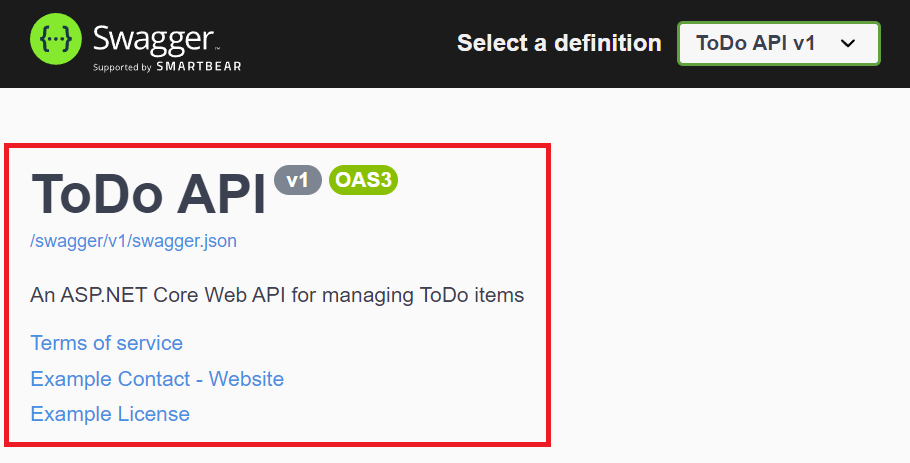
XML 注释
可使用以下方法启用 XML 注释:
- 在解决方案资源管理器中右键单击该项目,然后选择“”。
- 将 GenerateDocumentationFile 添加到
.csproj文件:
<PropertyGroup>
<GenerateDocumentationFile>true</GenerateDocumentationFile>
</PropertyGroup>
启用 XML 注释,为未记录的公共类型和成员提供调试信息。 警告消息指示未记录的类型和成员。 例如,以下消息指示违反警告代码 1591:
warning CS1591: Missing XML comment for publicly visible type or member 'TodoController'
要在项目范围内取消警告,请定义要在项目文件中忽略的以分号分隔的警告代码列表。 将警告代码追加到 $(NoWarn); 也会应用 C# 默认值。
<PropertyGroup>
<GenerateDocumentationFile>true</GenerateDocumentationFile>
<NoWarn>$(NoWarn);1591</NoWarn>
</PropertyGroup>
要仅针对特定成员取消警告,请将代码附入 #pragma warning 预处理程序指令中。 此方法对于不应通过 API 文档公开的代码非常有用。在以下示例中,将忽略整个 TodoContext 类的警告代码 CS1591。 在类定义结束时还原警告代码的强制执行。 使用逗号分隔的列表指定多个警告代码。
namespace SwashbuckleSample.Models;
#pragma warning disable CS1591
public class TodoContext : DbContext
{
public TodoContext(DbContextOptions<TodoContext> options) : base(options) { }
public DbSet<TodoItem> TodoItems => Set<TodoItem>();
}
#pragma warning restore CS1591
将 Swagger 配置为使用按照上述说明生成的 XML 文件。 对于 Linux 或非 Windows 操作系统,文件名和路径区分大小写。 例如,TodoApi.XML 文件在 Windows 上有效,但在 Ubuntu 上无效。
builder.Services.AddSwaggerGen(options =>
{
options.SwaggerDoc("v1", new OpenApiInfo
{
Version = "v1",
Title = "ToDo API",
Description = "An ASP.NET Core Web API for managing ToDo items",
TermsOfService = new Uri("https://example.com/terms"),
Contact = new OpenApiContact
{
Name = "Example Contact",
Url = new Uri("https://example.com/contact")
},
License = new OpenApiLicense
{
Name = "Example License",
Url = new Uri("https://example.com/license")
}
});
// using System.Reflection;
var xmlFilename = $"{Assembly.GetExecutingAssembly().GetName().Name}.xml";
options.IncludeXmlComments(Path.Combine(AppContext.BaseDirectory, xmlFilename));
});
在上述代码中,反射用于生成与 Web API 项目相匹配的 XML 文件名。 AppContext.BaseDirectory属性用于构造 XML 文件的路径。 一些 Swagger 功能(例如,输入参数的架构,或各自属性中的 HTTP 方法和响应代码)无需使用 XML 文档文件即可起作用。 对于大多数功能(即方法摘要以及参数说明和响应代码说明),必须使用 XML 文件。
通过向节标题添加说明,将三斜杠注释添加到操作增强了 Swagger UI。 执行 < 操作前添加 > 元素:
/// <summary>
/// Deletes a specific TodoItem.
/// </summary>
/// <param name="id"></param>
/// <returns></returns>
[HttpDelete("{id}")]
public async Task<IActionResult> Delete(long id)
{
var item = await _context.TodoItems.FindAsync(id);
if (item is null)
{
return NotFound();
}
_context.TodoItems.Remove(item);
await _context.SaveChangesAsync();
return NoContent();
}
Swagger UI 显示上述代码的 <summary> 元素的内部文本:
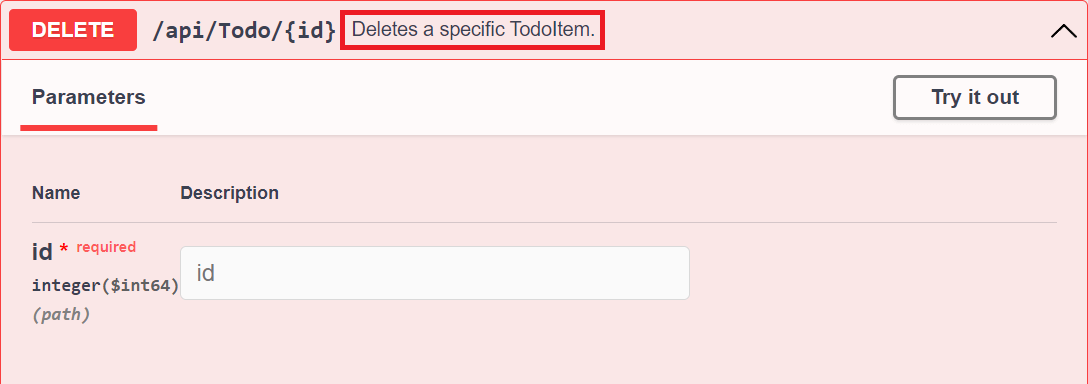
生成的 JSON 架构驱动 UI:
"delete": {
"tags": [
"Todo"
],
"summary": "Deletes a specific TodoItem.",
"parameters": [
{
"name": "id",
"in": "path",
"description": "",
"required": true,
"schema": {
"type": "integer",
"format": "int64"
}
}
],
"responses": {
"200": {
"description": "Success"
}
}
},
将 <remarks> 元素添加到 Create 操作方法文档。 它可以补充 <summary> 元素中指定的信息,并提供更可靠的 Swagger UI。
<remarks> 元素内容可包含文本、JSON 或 XML。
/// <summary>
/// Creates a TodoItem.
/// </summary>
/// <param name="item"></param>
/// <returns>A newly created TodoItem</returns>
/// <remarks>
/// Sample request:
///
/// POST /Todo
/// {
/// "id": 1,
/// "name": "Item #1",
/// "isComplete": true
/// }
///
/// </remarks>
/// <response code="201">Returns the newly created item</response>
/// <response code="400">If the item is null</response>
[HttpPost]
[ProducesResponseType(StatusCodes.Status201Created)]
[ProducesResponseType(StatusCodes.Status400BadRequest)]
public async Task<IActionResult> Create(TodoItem item)
{
_context.TodoItems.Add(item);
await _context.SaveChangesAsync();
return CreatedAtAction(nameof(Get), new { id = item.Id }, item);
}
请注意带这些附加注释的 UI 增强功能:

数据批注
使用 System.ComponentModel.DataAnnotations 命名空间中找到的属性来标记模型,以帮助驱动 Swagger UI 组件。
将 [Required] 属性添加到 Name 类的 TodoItem 属性:
using System.ComponentModel;
using System.ComponentModel.DataAnnotations;
namespace SwashbuckleSample.Models;
public class TodoItem
{
public long Id { get; set; }
[Required]
public string Name { get; set; } = null!;
[DefaultValue(false)]
public bool IsComplete { get; set; }
}
此属性的状态更改 UI 行为并更改基础 JSON 架构:
"schemas": {
"TodoItem": {
"required": [
"name"
],
"type": "object",
"properties": {
"id": {
"type": "integer",
"format": "int64"
},
"name": {
"type": "string"
},
"isComplete": {
"type": "boolean",
"default": false
}
},
"additionalProperties": false
}
},
将 [Produces("application/json")] 属性添加到 API 控制器。 这样做的目的是声明控制器的操作支持 application/json 的响应内容类型:
[ApiController]
[Route("api/[controller]")]
[Produces("application/json")]
public class TodoController : ControllerBase
{
“媒体类型”下拉列表选此内容类型作为控制器的默认 GET 操作:
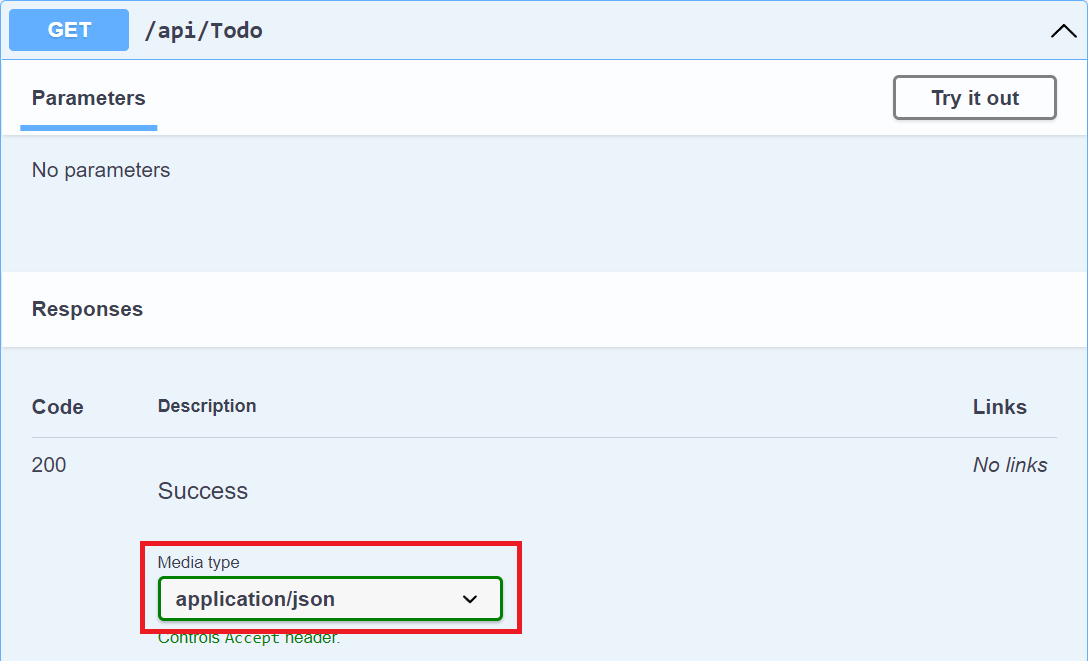
随着 Web API 中的数据注释的使用越来越多,UI 和 API 帮助页变得更具说明性和更为有用。
描述响应类型
使用 Web API 的开发人员最关心的问题是返回的内容,特别是响应类型和错误代码(如果不标准)。 在 XML 注释和数据注释中表示响应类型和错误代码。
Create 操作成功后返回 HTTP 201 状态代码。 发布的请求正文为 NULL 时,将返回 HTTP 400 状态代码。 如果 Swagger UI 中没有提供合适的文档,那么使用者会缺少对这些预期结果的了解。 在以下示例中,通过添加突出显示的行解决此问题:
/// <summary>
/// Creates a TodoItem.
/// </summary>
/// <param name="item"></param>
/// <returns>A newly created TodoItem</returns>
/// <remarks>
/// Sample request:
///
/// POST /Todo
/// {
/// "id": 1,
/// "name": "Item #1",
/// "isComplete": true
/// }
///
/// </remarks>
/// <response code="201">Returns the newly created item</response>
/// <response code="400">If the item is null</response>
[HttpPost]
[ProducesResponseType(StatusCodes.Status201Created)]
[ProducesResponseType(StatusCodes.Status400BadRequest)]
public async Task<IActionResult> Create(TodoItem item)
{
_context.TodoItems.Add(item);
await _context.SaveChangesAsync();
return CreatedAtAction(nameof(Get), new { id = item.Id }, item);
}
Swagger UI 现在清楚地记录预期的 HTTP 响应代码:

约定可以用作使用 [ProducesResponseType] 显式修饰各操作的替代方法。 有关详细信息,请参阅使用 Web API 约定。
为了支持 [ProducesResponseType] 修饰,Swashbuckle.AspNetCore.Annotations 包提供了用于启用和丰富响应、架构和参数元数据的扩展。
自定义 UI
默认 UI 既实用又可呈现。 但是,API 文档页应代表品牌或主题。 将 Swashbuckle 组件标记为需要添加资源以提供静态文件,并构建文件夹结构以托管这些文件。
启用静态文件中间件:
app.UseHttpsRedirection();
app.UseStaticFiles();
app.MapControllers();
若要插入其他 CSS 样式表,请将其添加到项目的 wwwroot 文件夹中,并在中间件选项中指定相对路径:
if (app.Environment.IsDevelopment())
{
app.UseSwaggerUI(options => // UseSwaggerUI is called only in Development.
{
options.InjectStylesheet("/swagger-ui/custom.css");
});
}
其他资源
Swashbuckle 有三个主要组成部分:
Swashbuckle.AspNetCore.Swagger:将
SwaggerDocument对象公开为 JSON 终结点的 Swagger 对象模型和中间件。Swashbuckle.AspNetCore.SwaggerGen:从路由、控制器和模型直接生成
SwaggerDocument对象的 Swagger 生成器。 它通常与 Swagger 终结点中间件结合使用,以自动显示 Swagger JSON。Swashbuckle.AspNetCore.SwaggerUI:Swagger UI 工具的嵌入式版本。 它解释了 Swagger JSON,以便为描述 Web API 功能构建丰富、可自定义的体验。 它包括针对公共方法的内置测试工具。
包安装
可以使用以下方法来添加 Swashbuckle:
从“程序包管理器控制台”窗口:
转到“视图”“其他窗口”>“程序包管理器控制台”
导航到包含
TodoApi.csproj文件的目录请执行以下命令:
Install-Package Swashbuckle.AspNetCore -Version 5.6.3
从“管理 NuGet 程序包”对话框中:
- 右键单击“解决方案资源管理器”“管理 NuGet 包”中的项目
- 将“包源”设置为“nuget.org”
- 确保启用“包括预发行版”选项
- 在搜索框中输入“Swashbuckle.AspNetCore”
- 从“浏览”选项卡中选择最新的“Swashbuckle.AspNetCore”包,然后单击“安装”
添加并配置 Swagger 中间件
将 Swagger 生成器添加到 Startup.ConfigureServices 方法中的服务集合中:
public void ConfigureServices(IServiceCollection services)
{
services.AddDbContext<TodoContext>(opt =>
opt.UseInMemoryDatabase("TodoList"));
services.AddControllers();
// Register the Swagger generator, defining 1 or more Swagger documents
services.AddSwaggerGen();
}
在 Startup.Configure 方法中,启用中间件为生成的 JSON 文档和 Swagger UI 提供服务:
public void Configure(IApplicationBuilder app, IWebHostEnvironment env)
{
if (env.IsDevelopment())
{
// Enable middleware to serve generated Swagger as a JSON endpoint.
app.UseSwagger();
// Enable middleware to serve swagger-ui (HTML, JS, CSS, etc.)
app.UseSwaggerUI();
}
app.UseRouting();
app.UseEndpoints(endpoints =>
{
endpoints.MapControllers();
});
}
Note
Swashbuckle 依赖于 MVC 的 Microsoft.AspNetCore.Mvc.ApiExplorer 来发现路由和终结点。 如果项目调用 AddMvc,则自动发现路由和终结点。 调用 AddMvcCore 时,必须显式调用 AddApiExplorer 方法。 有关详细信息,请参阅 Swashbuckle、ApiExplorer 和路由。
在开发过程中,前述的 UseSwaggerUI 方法调用会启用 Swagger UI 工具的嵌入版本。 这取决于静态文件中间件。 如果以 .NET Framework 或 .NET Core 1.x 为目标,请将 Microsoft.AspNetCore.StaticFiles NuGet 包添加到项目。
启动应用,并导航到 http://localhost:<port>/swagger/v1/swagger.json。 生成的描述终结点的文档显示在 OpenAPI 规范 (openapi.json) 中。
可在 http://localhost:<port>/swagger 找到 Swagger UI。 通过 Swagger UI 浏览 API,并将其合并其他计划中。
Tip
要在应用的根 (http://localhost:<port>/) 处提供 Swagger UI,请将 RoutePrefix 属性设置为空字符串:
// // UseSwaggerUI Protected by if (env.IsDevelopment())
app.UseSwaggerUI(c => // UseSwaggerUI Protected by if (env.IsDevelopment())
{
c.SwaggerEndpoint("/swagger/v1/swagger.json", "My API V1");
c.RoutePrefix = string.Empty;
});
如果使用目录及 IIS 或反向代理,请使用 ./ 前缀将 Swagger 终结点设置为相对路径。 例如,./swagger/v1/swagger.json。 使用 /swagger/v1/swagger.json 指示应用在 URL 的真实根目录中查找 JSON 文件(如果使用,加上路由前缀)。 例如,请使用 http://localhost:<port>/<route_prefix>/swagger/v1/swagger.json 而不是 http://localhost:<port>/<virtual_directory>/<route_prefix>/swagger/v1/swagger.json。
Note
默认情况下,Swashbuckle 会在 3.0 版规范(官方称为 OpenAPI 规范)中生成并公开 Swagger JSON。 为了支持向后兼容性,可以改为选择以 2.0 格式公开 JSON。 对于当前支持 OpenAPI 版本 2.0 的 Microsoft Power Apps 和 Microsoft Flow 等集成,此 2.0 格式非常重要。 若要选择采用 2.0 格式,请在 SerializeAsV2 中设置 Startup.Configure 属性:
public void Configure(IApplicationBuilder app, IWebHostEnvironment env)
{
if (env.IsDevelopment())
{
// Enable middleware to serve generated Swagger as a JSON endpoint.
app.UseSwagger(c =>
{
c.SerializeAsV2 = true;
});
// Enable middleware to serve swagger-ui (HTML, JS, CSS, etc.),
// specifying the Swagger JSON endpoint.
// UseSwaggerUI is called only in Development.
app.UseSwaggerUI(c => // UseSwaggerUI Protected by if (env.IsDevelopment())
{
c.SwaggerEndpoint("/swagger/v1/swagger.json", "My API V1");
});
}
app.UseRouting();
app.UseEndpoints(endpoints =>
{
endpoints.MapControllers();
});
}
自定义和扩展
Swagger 提供了为对象模型进行归档和自定义 UI 以匹配你的主题的选项。
在 Startup 类中,添加以下命名空间:
using System;
using System.Reflection;
using System.IO;
API 信息和说明
传递给 AddSwaggerGen 方法的配置操作会添加诸如作者、许可证和说明的信息:
在 Startup 类中,导入以下命名空间来使用 OpenApiInfo 类:
using Microsoft.OpenApi.Models;
使用 OpenApiInfo 类修改 UI 中显示的信息:
// Register the Swagger generator, defining 1 or more Swagger documents
services.AddSwaggerGen(c =>
{
c.SwaggerDoc("v1", new OpenApiInfo
{
Version = "v1",
Title = "ToDo API",
Description = "A simple example ASP.NET Core Web API",
TermsOfService = new Uri("https://example.com/terms"),
Contact = new OpenApiContact
{
Name = "Shayne Boyer",
Email = string.Empty,
Url = new Uri("https://twitter.com/spboyer"),
},
License = new OpenApiLicense
{
Name = "Use under LICX",
Url = new Uri("https://example.com/license"),
}
});
});
Swagger UI 显示版本的信息:

XML 注释
可使用以下方法启用 XML 注释:
- 在解决方案资源管理器中右键单击该项目,然后选择“”。
- 手动将突出显示的行添加到
.csproj文件:
<PropertyGroup>
<GenerateDocumentationFile>true</GenerateDocumentationFile>
<NoWarn>$(NoWarn);1591</NoWarn>
</PropertyGroup>
启用 XML 注释,为未记录的公共类型和成员提供调试信息。 警告消息指示未记录的类型和成员。 例如,以下消息指示违反警告代码 1591:
warning CS1591: Missing XML comment for publicly visible type or member 'TodoController.GetAll()'
要在项目范围内取消警告,请定义要在项目文件中忽略的以分号分隔的警告代码列表。 将警告代码追加到 $(NoWarn); 也会应用 C# 默认值。
<PropertyGroup>
<GenerateDocumentationFile>true</GenerateDocumentationFile>
<NoWarn>$(NoWarn);1591</NoWarn>
</PropertyGroup>
要仅针对特定成员取消警告,请将代码附入 #pragma warning 预处理程序指令中。 此方法对于不应通过 API 文档公开的代码非常有用。在以下示例中,将忽略整个 Program 类的警告代码 CS1591。 在类定义结束时还原警告代码的强制执行。 使用逗号分隔的列表指定多个警告代码。
namespace TodoApi
{
#pragma warning disable CS1591
public class Program
{
public static void Main(string[] args) =>
BuildWebHost(args).Run();
public static IWebHost BuildWebHost(string[] args) =>
WebHost.CreateDefaultBuilder(args)
.UseStartup<Startup>()
.Build();
}
#pragma warning restore CS1591
}
将 Swagger 配置为使用按照上述说明生成的 XML 文件。 对于 Linux 或非 Windows 操作系统,文件名和路径区分大小写。 例如,TodoApi.XML 文件在 Windows 上有效,但在 Ubuntu 上无效。
public void ConfigureServices(IServiceCollection services)
{
services.AddDbContext<TodoContext>(opt =>
opt.UseInMemoryDatabase("TodoList"));
services.AddControllers();
// Register the Swagger generator, defining 1 or more Swagger documents
services.AddSwaggerGen(c =>
{
c.SwaggerDoc("v1", new OpenApiInfo
{
Version = "v1",
Title = "ToDo API",
Description = "A simple example ASP.NET Core Web API",
TermsOfService = new Uri("https://example.com/terms"),
Contact = new OpenApiContact
{
Name = "Shayne Boyer",
Email = string.Empty,
Url = new Uri("https://twitter.com/spboyer"),
},
License = new OpenApiLicense
{
Name = "Use under LICX",
Url = new Uri("https://example.com/license"),
}
});
// Set the comments path for the Swagger JSON and UI.
var xmlFile = $"{Assembly.GetExecutingAssembly().GetName().Name}.xml";
var xmlPath = Path.Combine(AppContext.BaseDirectory, xmlFile);
c.IncludeXmlComments(xmlPath);
});
}
在上述代码中,反射用于生成与 Web API 项目相匹配的 XML 文件名。 AppContext.BaseDirectory属性用于构造 XML 文件的路径。 一些 Swagger 功能(例如,输入参数的架构,或各自属性中的 HTTP 方法和响应代码)无需使用 XML 文档文件即可起作用。 对于大多数功能(即方法摘要以及参数说明和响应代码说明),必须使用 XML 文件。
通过向节标题添加说明,将三斜杠注释添加到操作增强了 Swagger UI。 执行 < 操作前添加 > 元素:
/// <summary>
/// Deletes a specific TodoItem.
/// </summary>
/// <param name="id"></param>
[HttpDelete("{id}")]
public IActionResult Delete(long id)
{
var todo = _context.TodoItems.Find(id);
if (todo == null)
{
return NotFound();
}
_context.TodoItems.Remove(todo);
_context.SaveChanges();
return NoContent();
}
Swagger UI 显示上述代码的 <summary> 元素的内部文本:

生成的 JSON 架构驱动 UI:
"delete": {
"tags": [
"Todo"
],
"summary": "Deletes a specific TodoItem.",
"operationId": "ApiTodoByIdDelete",
"consumes": [],
"produces": [],
"parameters": [
{
"name": "id",
"in": "path",
"description": "",
"required": true,
"type": "integer",
"format": "int64"
}
],
"responses": {
"200": {
"description": "Success"
}
}
}
将 <remarks> 元素添加到 Create 操作方法文档。 它可以补充 <summary> 元素中指定的信息,并提供更可靠的 Swagger UI。
<remarks> 元素内容可包含文本、JSON 或 XML。
/// <summary>
/// Creates a TodoItem.
/// </summary>
/// <remarks>
/// Sample request:
///
/// POST /Todo
/// {
/// "id": 1,
/// "name": "Item1",
/// "isComplete": true
/// }
///
/// </remarks>
/// <param name="item"></param>
/// <returns>A newly created TodoItem</returns>
/// <response code="201">Returns the newly created item</response>
/// <response code="400">If the item is null</response>
[HttpPost]
[ProducesResponseType(StatusCodes.Status201Created)]
[ProducesResponseType(StatusCodes.Status400BadRequest)]
public ActionResult<TodoItem> Create(TodoItem item)
{
_context.TodoItems.Add(item);
_context.SaveChanges();
return CreatedAtRoute("GetTodo", new { id = item.Id }, item);
}
请注意带这些附加注释的 UI 增强功能:

数据批注
使用 System.ComponentModel.DataAnnotations 命名空间中找到的属性来标记模型,以帮助驱动 Swagger UI 组件。
将 [Required] 属性添加到 Name 类的 TodoItem 属性:
using System.ComponentModel;
using System.ComponentModel.DataAnnotations;
namespace TodoApi.Models
{
public class TodoItem
{
public long Id { get; set; }
[Required]
public string Name { get; set; }
[DefaultValue(false)]
public bool IsComplete { get; set; }
}
}
此属性的状态更改 UI 行为并更改基础 JSON 架构:
"definitions": {
"TodoItem": {
"required": [
"name"
],
"type": "object",
"properties": {
"id": {
"format": "int64",
"type": "integer"
},
"name": {
"type": "string"
},
"isComplete": {
"default": false,
"type": "boolean"
}
}
}
},
将 [Produces("application/json")] 属性添加到 API 控制器。 这样做的目的是声明控制器的操作支持 application/json 的响应内容类型:
[Produces("application/json")]
[Route("api/[controller]")]
[ApiController]
public class TodoController : ControllerBase
{
private readonly TodoContext _context;
“响应内容类型”下拉列表选此内容类型作为控制器的默认 GET 操作:
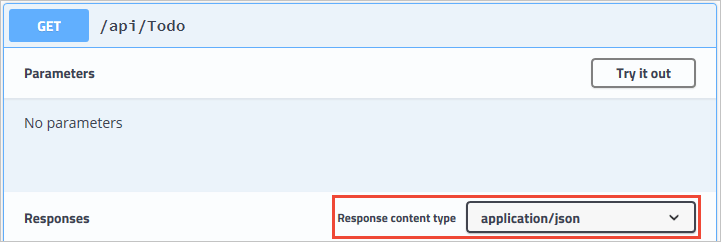
随着 Web API 中的数据注释的使用越来越多,UI 和 API 帮助页变得更具说明性和更为有用。
描述响应类型
使用 Web API 的开发人员最关心的问题是返回的内容,特别是响应类型和错误代码(如果不标准)。 在 XML 注释和数据注释中表示响应类型和错误代码。
Create 操作成功后返回 HTTP 201 状态代码。 发布的请求正文为 NULL 时,将返回 HTTP 400 状态代码。 如果 Swagger UI 中没有提供合适的文档,那么使用者会缺少对这些预期结果的了解。 在以下示例中,通过添加突出显示的行解决此问题:
/// <summary>
/// Creates a TodoItem.
/// </summary>
/// <remarks>
/// Sample request:
///
/// POST /Todo
/// {
/// "id": 1,
/// "name": "Item1",
/// "isComplete": true
/// }
///
/// </remarks>
/// <param name="item"></param>
/// <returns>A newly created TodoItem</returns>
/// <response code="201">Returns the newly created item</response>
/// <response code="400">If the item is null</response>
[HttpPost]
[ProducesResponseType(StatusCodes.Status201Created)]
[ProducesResponseType(StatusCodes.Status400BadRequest)]
public ActionResult<TodoItem> Create(TodoItem item)
{
_context.TodoItems.Add(item);
_context.SaveChanges();
return CreatedAtRoute("GetTodo", new { id = item.Id }, item);
}
Swagger UI 现在清楚地记录预期的 HTTP 响应代码:
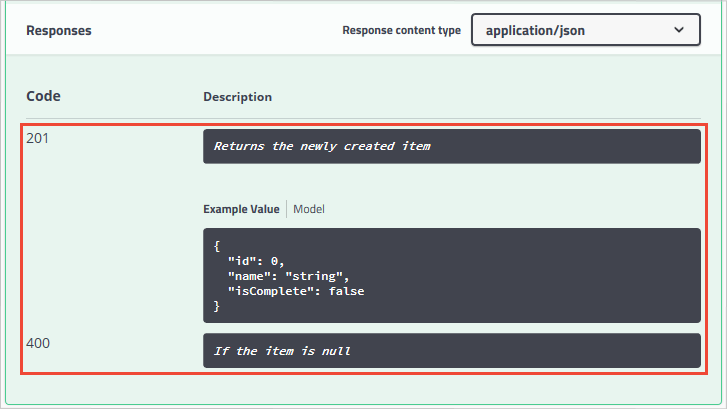
在 ASP.NET Core 2.2 或更高版本中,约定可以用作使用 [ProducesResponseType] 显式修饰各操作的替代方法。 有关详细信息,请参阅使用 Web API 约定。
为了支持 [ProducesResponseType] 修饰,Swashbuckle.AspNetCore.Annotations 包提供了用于启用和丰富响应、架构和参数元数据的扩展。
自定义 UI
默认 UI 既实用又可呈现。 但是,API 文档页应代表品牌或主题。 将 Swashbuckle 组件标记为需要添加资源以提供静态文件,并构建文件夹结构以托管这些文件。
如果以 .NET Framework 或 .NET Core 1.x 为目标,请将 Microsoft.AspNetCore.StaticFiles NuGet 包添加到项目:
<PackageReference Include="Microsoft.AspNetCore.StaticFiles" Version="2.1.1" />
如果以 .NET Core 2.x 为目标并使用元包,则已安装上述 NuGet 包。
启用静态文件中间件:
public void Configure(IApplicationBuilder app, IWebHostEnvironment env)
{
app.UseStaticFiles();
if (env.IsDevelopment())
{
// Enable middleware to serve generated Swagger as a JSON endpoint.
app.UseSwagger();
// Enable middleware to serve swagger-ui (HTML, JS, CSS, etc.),
// specifying the Swagger JSON endpoint.
app.UseSwaggerUI(c => // UseSwaggerUI Protected by if (env.IsDevelopment())
{
c.SwaggerEndpoint("/swagger/v1/swagger.json", "My API V1");
});
}
app.UseRouting();
app.UseEndpoints(endpoints =>
{
endpoints.MapControllers();
});
}
若要插入其他 CSS 样式表,请将其添加到项目的 wwwroot 文件夹中,并在中间件选项中指定相对路径:
if (env.IsDevelopment())
{
app.UseSwaggerUI(c =>
{
c.InjectStylesheet("/swagger-ui/custom.css");
}
}
